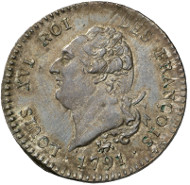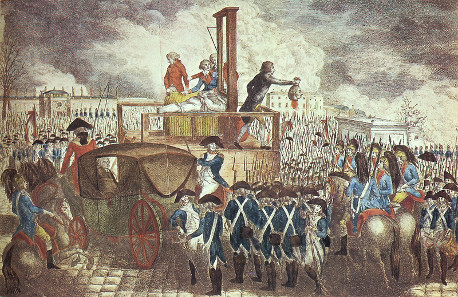Human faces, part 44: Flight to Varennes
courtesy of the MoneyMuseum, Zurich
translated by Teresa Teklic
Why was the human head the motif on coins for centuries, no, for millennia? And why did that change in the last 200 years? Ursula Kampmann is looking for answers to these questions in her book “MenschenGesichter” (“Human faces”), from which the texts in this series are taken.
Louis XVI, King of France (1774-1792). 30 sols (1/4 écu constitutionnel) 1791. Head of Louis to the left. R. Winged, upright genius to the right, inscribing a table with the word “Constitution”, below the inscription “L’AN 3 DE LA LIBERTÉ” (Year 3 of Freedom). © MoneyMuseum, Zurich.
It is a dark night, this night from June 21 to June 22, 1791, in which individual shapes sneak out the Tuileries. Louis XVI, King of France, has decided to leave France and join his relatives abroad. This must happen in secret. Even though he is not guarded by soldiers, all eyes in Paris are on him.
But he succeeds: Nobody stops the fugitives. A carriage stands waiting, ready to get the royal family out of Paris. A loyal admirer of Marie-Antoinette drives the carriage the first section of the route. After that the fugitives change to the official stagecoach. The nanny poses as the Baroness Korff, the king as her valet. In Clermont, they expect to meet loyal soldiers, who will accompany Louis on the rest of his travels. At least that is the plan. Unfortunately, the whole undertaking seems to be jinxed from the beginning. They do not keep to the schedule. Twice the horses fall, twice the bridle rips and has to be mended with great difficulty. An all this while the loyal soldiers are waiting in Clermont. They are waiting on horseback, right in the centre of the marketplace, ready to go, and the peasants are drawing closer, ganging up on them. What do these silent warriors want? Were they sent to put down the revolution? The situation is about to escalate. The first peasants are reaching for their weapons, when the officer orders the retreat. They would have to meet the king later.
So Louis is told in Clermont that he needs to drive on to Varennes, and make haste, make haste! Once in Varennes, the driver remarks drily that the horses are tired and need to rest. A postmaster approaches. He cannot believe what he sees when he looks inside the carriage: The man inside looks just like the king, he recognises him from the depiction on his banknote. The postmaster runs across the entire village to tell everyone about it: “It is the king, in this carriage, the King of France, trying to escape!”
Execution of Louis XVI. Copperplate print, 1793. Source: Wikicommons.
The rest of the story is quickly told. The citizens of Varennes detained the escaping monarch until representatives of the national assembly arrived and carried the king back to Paris. The attempted escape had destroyed the people’s trust in a monarchic system entirely. More than 6,000 Parisian citizens signed a petition which demanded that the king be tried for high treason. And so it happened: The King of France was deposed, tried as Louis Capet and executed on 21 January 1793.
What happens to France after the execution of its king will be the story of the next episode.
You can find all episodes in the series here.
A German edition of the book “MenschenGesichter” is available in print and as ebook on the site of the Conzett Verlag.








